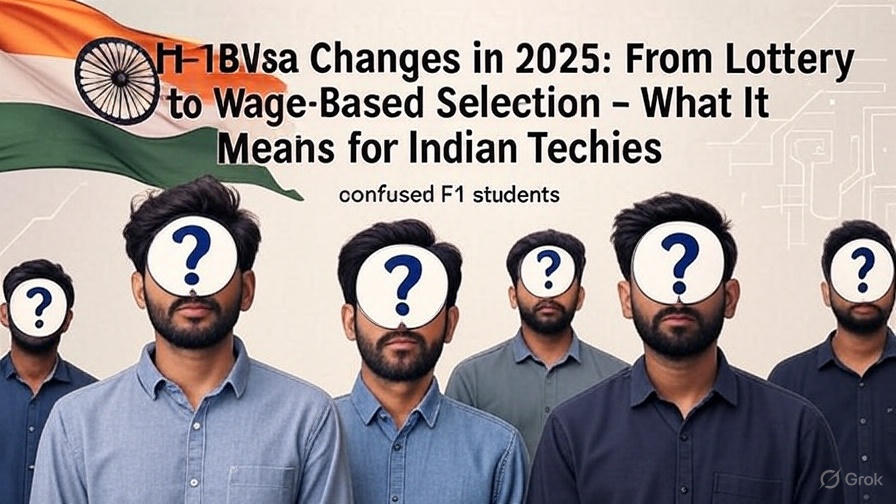The U.S. H-1B visa program, a gateway for thousands of skilled professionals from India to pursue careers in the United States, is undergoing major changes. The long-standing lottery-based system, which offered equal opportunity to all eligible applicants, is now set to be replaced by a wage-based selection process. This shift could significantly reshape the future of Indian IT professionals, students, and employers aiming for the U.S. tech market. In this article, we compare the old and new systems, analyze the pros and cons, and explore what these changes mean for Indian techies.
Current H-1B System (Lottery-Based)
- Random Lottery Selection: Annually, 85,000 H-1B visas (65,000 for general applicants + 20,000 for advanced degree holders) are awarded via a lottery, giving all eligible applicants an equal chance regardless of seniority or salary.
- Inclusive Across Wage Levels: Selection has traditionally ignored the salary offered, enabling a level playing field for new graduates, mid-tier roles, and seasoned experts
In this article, we explore the complexities of election politics on a global scale, analyzing major elections, international implications, key political movements, and the role of technology in shaping modern governance. Elections serve as the mechanism through which governments are formed and political power is distributed. Their importance lies in.
Recent Enhancements (Effective Jan 17, 2025):
- Expanded Cap-Gap Protection: F-1 students transitioning to H-1B can now maintain status and work authorization up to April 1, up from October 1. After 2025: Students can now stay and work up to April 1 of the following year, even if their OPT ends earlier.
- Clarified “Specialty Occupation” Definition: Roles now need normally (not universally) require a bachelor’s degree. and the field of study must be directly related to job duties.
- Strengthened Compliance & Oversight: USCIS can conduct site visits—even at third-party or home offices—and more strictly enforce program integrity.
Proposed Changes (Wage-Based Selection)
- Weighted Selection Over Lottery: The Department of Homeland Security (DHS) is proposing to replace the lottery system with a wage-priority model, ranking applications by salary tiers—favoring higher wages.,(higher wages = better chances).
- Regulatory Status: The proposal was cleared by the Office of Management and Budget (OMB) on August 8, 2025, and is expected to take effect for the FY 2026 or FY 2027 H-1B season, (applications filed in March 2026 or 2027).
Side-by-Side Comparison
Feature | Current System | Proposed System |
Selection Method | Random lottery | Wage-tier ranking |
Fairness | Equal opportunity | Favors high-salary applicants |
Entry-Level Impact | Moderate (equal chance) | Negative—less chance for graduates, lower salaries penalized |
Employer Strategy | Uniform across salary levels | Higher-paying offers needed for competitiveness |
Stability (Cap-Gap) | Extended now to April 1 (2025 update) | Unchanged |
Compliance Oversight | Strong (as of Jan 2025) | Same |
Is This Good or Bad for Indian Techies?
- Challenges: -Entry-Level Disadvantage: Fresh graduates and early-career professionals may find it harder to compete without high salaries. They may struggle to secure visas due to lower salary offers.
- Higher Salary Pressure: Employers, especially startups or smaller firms, may face increased costs to remain competitive.
- Reward for Expertise: Senior professionals or niche-skilled (e.g., AI, cybersecurity) talent could see improved prospects.
- Market Alignment: U.S. authorities argue this protects local jobs and ensures fair wages and prioritizes highly skilled talent.
Final Thoughts
- The move from a lottery system to a wage-based selection for H-1B visas is one of the most significant immigration policy shifts in recent years. While it could favor highly paid roles and experienced professionals, it poses fresh challenges for entry-level applicants and cost-conscious employers.
Recommendations for Indian Techies:
- Negotiate Competitive Salaries:Aim for higher wage tiers to improve selection chances.
- Explore Alternatives:Consider L-1, O-1, or EB-3 visas if H-1B prospects decline.
- Stay Informed:Monitor USCIS updates for FY 2026/2027 implementation timelines.
This policy shift underscores the need for strategic career planning. Adaptability and early preparation will be key to navigating the new landscape.

















1 Comment
Eum optio repellendus deserunt quia Eaque eaque sed ut autem. Aperiam necessitatibus rem amet qui illo. sed est modi est autem maiores. Consequuntur deleniti dolores et Voluptatem dignissimos sit ut eveniet. Dignissimos quas officia ab excepturi sunt laudantium. Pariatur ullam ipsa. Ex amet magni voluptatem velit Ea saepe repellendus esse perspiciatis.